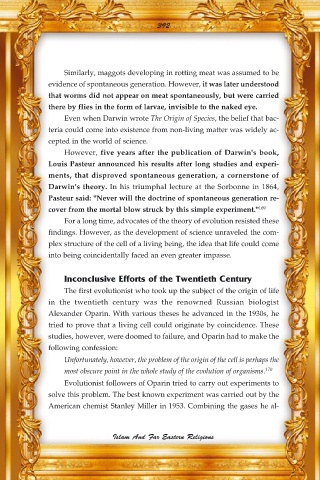Page 394 - Islam and Far Eastern Religions
P. 394
392
Similarly, maggots developing in rotting meat was assumed to be
evidence of spontaneous generation. However, it was later understood
that worms did not appear on meat spontaneously, but were carried
there by flies in the form of larvae, invisible to the naked eye.
Even when Darwin wrote The Origin of Species, the belief that bac-
teria could come into existence from non-living matter was widely ac-
cepted in the world of science.
However, five years after the publication of Darwin's book,
Louis Pasteur announced his results after long studies and experi-
ments, that disproved spontaneous generation, a cornerstone of
Darwin's theory. In his triumphal lecture at the Sorbonne in 1864,
Pasteur said: "Never will the doctrine of spontaneous generation re-
cover from the mortal blow struck by this simple experiment." 169
For a long time, advocates of the theory of evolution resisted these
findings. However, as the development of science unraveled the com-
plex structure of the cell of a living being, the idea that life could come
into being coincidentally faced an even greater impasse.
Inconclusive Efforts of the Twentieth Century
The first evolutionist who took up the subject of the origin of life
in the twentieth century was the renowned Russian biologist
Alexander Oparin. With various theses he advanced in the 1930s, he
tried to prove that a living cell could originate by coincidence. These
studies, however, were doomed to failure, and Oparin had to make the
following confession:
Unfortunately, however, the problem of the origin of the cell is perhaps the
most obscure point in the whole study of the evolution of organisms. 170
Evolutionist followers of Oparin tried to carry out experiments to
solve this problem. The best known experiment was carried out by the
American chemist Stanley Miller in 1953. Combining the gases he al-
Islam And Far Eastern Religions

